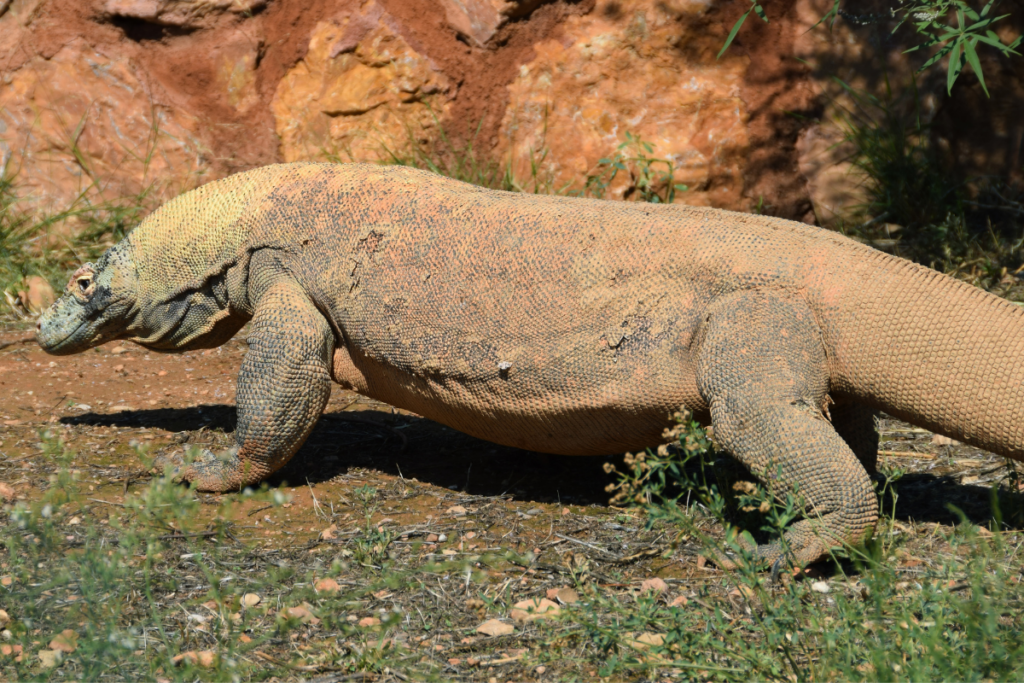Komodo Island, part of Indonesia’s Lesser Sunda chain of islands, is home to one of the most remarkable creatures on Earth—the Komodo dragon (Varanus komodoensis).
Known for their impressive size, predatory prowess, and distinctive appearance, Komodo dragons are a symbol of the raw, untamed nature that still exists in some corners of our planet.
This article delves into the biology, behavior, habitat, conservation status, and the cultural significance of these extraordinary reptiles, offering a comprehensive overview of the giants of Komodo Island.
Biological Characteristics
Physical Description

Komodo dragons are the largest living lizards, with males typically reaching lengths of 2.5 to 3 meters (8 to 10 feet) and weighing around 70 to 90 kilograms (154 to 198 pounds).
Females are generally smaller, averaging about 2.3 meters (7.5 feet) in length and weighing up to 50 kilograms (110 pounds).
These formidable reptiles are characterized by their robust bodies, strong limbs, and long, muscular tails.
Their skin is rough and covered with small scales, which are reinforced with tiny bones called osteoderms, providing protection against physical injuries.
The coloration of Komodo dragons varies, with adults usually displaying a uniform grayish-brown hue, while juveniles exhibit more vibrant patterns of yellow, green, and brown.
Their powerful jaws are equipped with serrated teeth, which are periodically replaced throughout their lives.
A notable feature of their anatomy is the long, forked tongue, which they use to sense their environment and detect prey.
Physiology and Adaptations
Komodo dragons possess several unique physiological traits that contribute to their status as apex predators.
One of the most significant is their highly developed sense of smell, facilitated by their forked tongues and Jacobson’s organs.
By flicking their tongues in and out, they can detect chemical cues in the air, allowing them to locate carcasses from several kilometers away.
Their musculature is another critical adaptation, enabling them to deliver powerful bites and subdue large prey.
Despite their bulk, Komodo dragons are capable of surprising bursts of speed, reaching up to 20 kilometers per hour (12.4 miles per hour) over short distances.
They are also excellent swimmers, often moving between islands in their search for food.
Additionally, recent studies have revealed that Komodo dragons possess venom glands in their lower jaws.
The venom contains a mix of toxins that inhibit blood clotting and lower blood pressure, leading to shock and rapid blood loss in their prey.
This discovery has reshaped the understanding of how these reptiles incapacitate and consume their prey.
Habitat and Distribution
Komodo dragons are endemic to the Indonesian islands of Komodo, Rinca, Flores, Gili Motang, and Gili Dasami.
These islands are characterized by their harsh, arid environments, featuring savannahs, tropical forests, and rugged hills.
The climate is generally hot and dry, with a pronounced wet season from December to March.
The dragons are most commonly found in open grasslands and along the coastlines, where they can easily access prey and bask in the sun to regulate their body temperature.
They are also known to inhabit forests, where the dense vegetation provides cover for ambushing prey.
The diverse terrain of these islands offers a variety of microhabitats, supporting a stable population of these reptiles.
Behavior and Diet
Hunting and Feeding Habits

Komodo dragons are carnivorous and primarily scavengers, though they are also formidable hunters.
Their diet includes carrion, deer, wild boar, water buffalo, and occasionally smaller dragons.
They have been known to consume invertebrates, birds, and eggs as well.
These reptiles employ a sit-and-wait strategy, using their camouflage to remain undetected by their prey.
When an opportunity arises, they launch a sudden attack, delivering a powerful bite and injecting venom into their victim.
Once the prey is subdued, Komodo dragons exhibit remarkable feeding behavior.
They are capable of consuming up to 80% of their body weight in a single meal.
Their flexible jaws, expandable stomachs, and loose articulations between their skull bones enable them to swallow large chunks of flesh.
After feeding, they retreat to shaded areas to digest their meal, a process that can take several days.
Social Structure and Reproduction
Komodo dragons are generally solitary creatures, coming together only to breed or feed on large carcasses.
During the breeding season, which occurs between May and August, males engage in ritualized combat to establish dominance and secure mating rights.
These battles involve wrestling and grappling, with the victor earning the right to mate with receptive females.
Females lay their eggs in September, typically in burrows or abandoned nests of megapode birds.
A clutch can contain up to 30 eggs, which incubate for around eight months.
The hatchlings are highly vulnerable and spend their early months in trees to avoid predation by adult dragons and other threats.
Juveniles feed on insects, small lizards, and birds until they are large enough to venture to the ground and compete for larger prey.
Conservation Status and Challenges
Threats to Survival
Despite their formidable presence, Komodo dragons face several threats that jeopardize their survival.
Habitat destruction due to human encroachment, agricultural expansion, and deforestation is a significant concern.
The islands’ ecosystems are fragile, and any alteration can have cascading effects on the resident wildlife.
Poaching and illegal trade also pose threats to Komodo dragon populations.
Although protected by Indonesian law and international agreements, these reptiles are sometimes captured for the exotic pet trade or killed for their skin and body parts.
Additionally, the introduction of non-native species, such as feral dogs and livestock, disrupts the ecological balance, leading to increased competition for resources and the spread of diseases.
Conservation Efforts
In response to these challenges, various conservation initiatives have been implemented to protect Komodo dragons and their habitat.
The establishment of Komodo National Park in 1980 was a crucial step, providing a protected area where these reptiles could thrive.
The park covers Komodo Island and several surrounding islands, encompassing a diverse range of habitats and supporting a stable population of dragons.
Efforts to mitigate human-wildlife conflict have also been undertaken, including community education programs to raise awareness about the importance of preserving these unique reptiles.
Sustainable tourism practices have been promoted to ensure that the influx of visitors does not negatively impact the environment or the dragons.
Conservation organizations and researchers continue to monitor Komodo dragon populations, studying their behavior, genetics, and health to develop effective management strategies.
Captive breeding programs have been established to safeguard against population declines and to reintroduce individuals into the wild if necessary.
Cultural Significance
Mythology and Folklore
Komodo dragons hold a significant place in the mythology and folklore of the indigenous people of the Lesser Sunda Islands.
They are often regarded as sacred creatures, believed to possess supernatural powers.
Local legends tell of a mythical dragon princess, who is considered the progenitor of both humans and Komodo dragons.
This cultural reverence has contributed to a degree of protection for these reptiles, as harming them is considered taboo.
Modern Symbolism
In contemporary times, Komodo dragons have become an emblem of Indonesian wildlife and natural heritage.
They attract tourists from around the world, drawn by the opportunity to witness these prehistoric-looking creatures in their natural habitat.
This tourism generates revenue that supports local economies and conservation efforts, highlighting the importance of preserving these unique reptiles for future generations.
Conclusion
The Komodo dragon is a marvel of evolution, embodying the raw power and adaptability that has allowed it to thrive in a challenging environment.
Its status as the largest living lizard, combined with its distinctive biological and behavioral traits, makes it a subject of fascination for scientists, conservationists, and the general public alike.
As efforts to protect and preserve these extraordinary creatures continue, it is hoped that future generations will also have the chance to marvel at the giant lizard of Komodo Island, a true testament to the wonders of our natural world.







